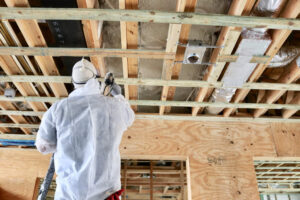What is Foam Insulation ?
Spray foam insulation is an insulation and air barrier material that seals walls, floors and ceiling cavities against air movement. This includes spaces around electrical outlets and light fixtures, and also where walls meet windows and doors.
Spray foam can be sprayed into an open cavity, like in new construction, attics, crawl spaces and rim joists.
Spray foam never loses its shape. Unlike conventional insulation materials, spray foam fills cracks, gaps and crevices on installation. It won’t compress, sag or settle over time.
How Spray Foam Works?
Open cell and closed cell spray foam insulates your home while creating an air seal. The insulation has many benefits including sound control, deterring mold growth, and reducing air flow while stopping drafts and cold floors. It also has the ability to help lower your monthly energy bills.
Spray foam insulation impacts the conduction (heat transfer) and the convection (air flow) which affects your home’s comfort and energy efficiency. Insulation’s overall job is to resist heat flow in or out of a space. It keeps your warm house warm in the winter and your cool home cool in the summer.
Air leakage is a problem for many homes and this contributes to the home’s energy loss . Some homes can leak enough air each day to fill two blimps, so imagine the impact that has on heating and cooling bills.
Some open cell spray foam insulation expands up to 100 times its original size to fill every nook and cranny in the cavity. With traditional insulation – fiberglass and cellulose – spaces and gaps that aren’t filled can leak air.
Using spray foam can lead to a draft-free and energy efficient home.
What Is the Difference Between Open Cell and Closed Cell Spray Foam Insulation?
Spray foam can be either open cell or closed cell foam insulation.
- Open cell spray foam is very light and pliable due to its composition. As open cell foam dries, the gas inside the cells escape through openings in the cell’s wall resulting in foam that is light and pliable that shifts as it settles.
- Closed cell spray foam is a much more dense and heavy material. It creates a dense surface that is more resistant to weathering and temperature change.


(please see more pictures in our portfolio)


